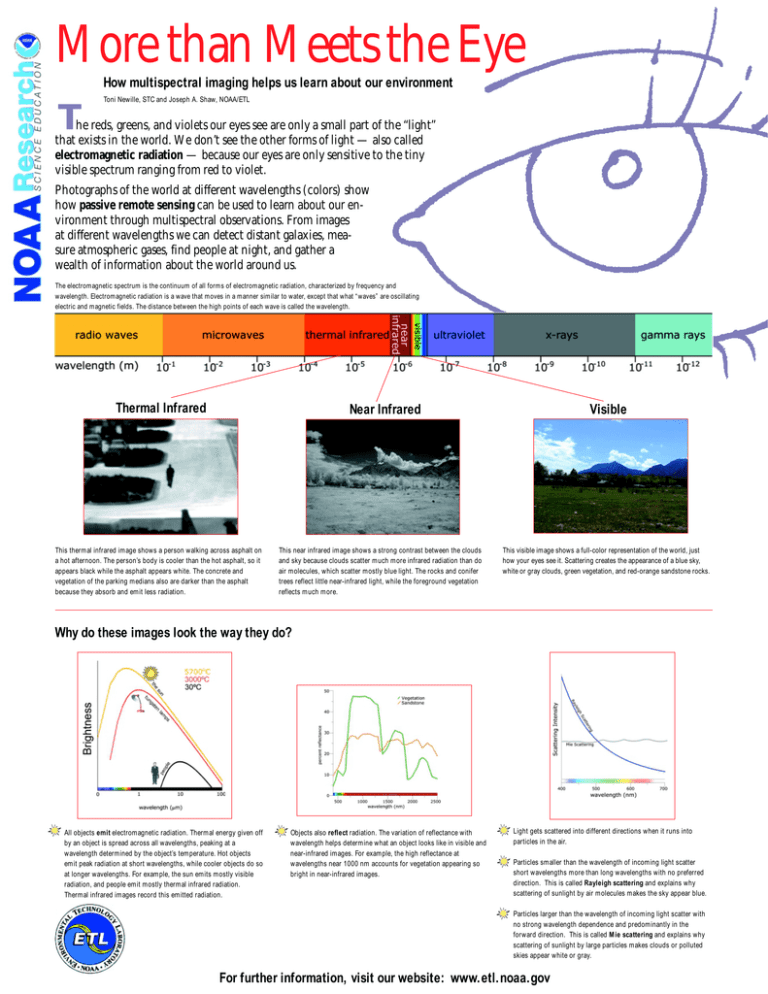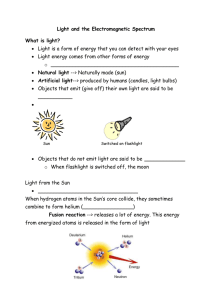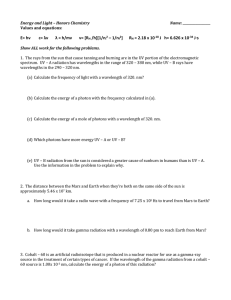Thermal Infrared Near Infrared Visible Why do these images look the
advertisement

More than Meets the Eye How multispectral imaging helps us learn about our environment Toni Newille, STC and Joseph A. Shaw, NOAA/ETL T he reds, greens, and violets our eyes see are only a small part of the “light” that exists in the world. We don’t see the other forms of light — also called electromagnetic radiation — because our eyes are only sensitive to the tiny visible spectrum ranging from red to violet. Photographs of the world at different wavelengths (colors) show how passive remote sensing can be used to learn about our environment through multispectral observations. From images at different wavelengths we can detect distant galaxies, measure atmospheric gases, find people at night, and gather a wealth of information about the world around us. The electromagnetic spectrum is the continuum of all forms of electromagnetic radiation, characterized by frequency and wavelength. Electromagnetic radiation is a wave that moves in a manner similar to water, except that what “waves” are oscillating electric and magnetic fields. The distance between the high points of each wave is called the wavelength. Thermal Infrared Near Infrared This thermal infrared image shows a person walking across asphalt on a hot afternoon. The person’s body is cooler than the hot asphalt, so it appears black while the asphalt appears white. The concrete and vegetation of the parking medians also are darker than the asphalt because they absorb and emit less radiation. This near infrared image shows a strong contrast between the clouds and sky because clouds scatter much more infrared radiation than do air molecules, which scatter mostly blue light. The rocks and conifer trees reflect little near-infrared light, while the foreground vegetation reflects much more. Visible This visible image shows a full-color representation of the world, just how your eyes see it. Scattering creates the appearance of a blue sky, white or gray clouds, green vegetation, and red-orange sandstone rocks. Why do these images look the way they do? All objects emit electromagnetic radiation. Thermal energy given off by an object is spread across all wavelengths, peaking at a wavelength determined by the object’s temperature. Hot objects emit peak radiation at short wavelengths, while cooler objects do so at longer wavelengths. For example, the sun emits mostly visible radiation, and people emit mostly thermal infrared radiation. Thermal infrared images record this emitted radiation. Objects also reflect radiation. The variation of reflectance with wavelength helps determine what an object looks like in visible and near-infrared images. For example, the high reflectance at wavelengths near 1000 nm accounts for vegetation appearing so bright in near-infrared images. Light gets scattered into different directions when it runs into particles in the air. Particles smaller than the wavelength of incoming light scatter short wavelengths more than long wavelengths with no preferred direction. This is called Rayleigh scattering and explains why scattering of sunlight by air molecules makes the sky appear blue. Particles larger than the wavelength of incoming light scatter with no strong wavelength dependence and predominantly in the forward direction. This is called Mie scattering and explains why scattering of sunlight by large particles makes clouds or polluted skies appear white or gray. For further information, visit our website: www.etl.noaa.gov



